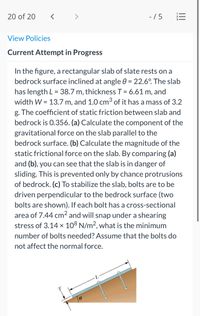
Elements Of Electromagnetics
7th Edition
ISBN: 9780190698614
Author: Sadiku, Matthew N. O.
Publisher: Oxford University Press
expand_more
expand_more
format_list_bulleted
Topic Video
Question

Transcribed Image Text:20 of 20
< >
- /5
View Policies
Current Attempt in Progress
In the figure, a rectangular slab of slate rests on a
bedrock surface inclined at angle 0 = 22.6°. The slab
has length L = 38.7 m, thickness T = 6.61 m, and
width W = 13.7 m, and 1.0 cm³ of it has a mass of 3.2
%3D
%3D
g. The coefficient of static friction between slab and
bedrock is 0.356. (a) Calculate the component of the
gravitational force on the slab parallel to the
bedrock surface. (b) Calculate the magnitude of the
static frictional force on the slab. By comparing (a)
and (b), you can see that the slab is in danger of
sliding. This is prevented only by chance protrusions
of bedrock. (c) To stabilize the slab, bolts are to be
driven perpendicular to the bedrock surface (two
bolts are shown). If each bolt has a cross-sectional
area of 7.44 cm2 and will snap under a shearing
stress of 3.14 x 108 N/m2, what is the minimum
number of bolts needed? Assume that the bolts do
not affect the normal force.
II
Expert Solution
This question has been solved!
Explore an expertly crafted, step-by-step solution for a thorough understanding of key concepts.
Step by stepSolved in 2 steps with 1 images

Knowledge Booster
Learn more about
Need a deep-dive on the concept behind this application? Look no further. Learn more about this topic, mechanical-engineering and related others by exploring similar questions and additional content below.Similar questions
- A 4-cm-OD, 3-cm-ID, circular shaft supports a 200 N load and is supported at two points, which are 2-m apart as shown here. What is the radius of curvature of the bending shaft when it is made of a material whose modulus of elasticity is 50 GPa? Multiple Choice O O O O 1087 m 5 m 432 m 65 marrow_forward1. For the rigid bodies shown in Figures 1-5, draw free body diagrams. Smooth surface A Figure 1: Figure 2: -P Sharp corner Barrow_forwardWrite the Shear Strain formula for Torsion for interior elements?arrow_forward
- K=17 so 107 MPa strength of material question.arrow_forwardThe structure consists of two bars. Axial loads 40 kN and 10 kN are loaded as shown in Figure B. Determine: a) Global stiffness matrix b) Nodal displacement c) Stress in each bar Table 2 Steel Aluminium Brass Area 400 350 350 (mm³) E(Gpa) 200 70 83 Aluminum Brass Steel 40 kN - 10 kN L 500 mm 400 mm 300 mmarrow_forward
arrow_back_ios
arrow_forward_ios
Recommended textbooks for you
 Elements Of ElectromagneticsMechanical EngineeringISBN:9780190698614Author:Sadiku, Matthew N. O.Publisher:Oxford University Press
Elements Of ElectromagneticsMechanical EngineeringISBN:9780190698614Author:Sadiku, Matthew N. O.Publisher:Oxford University Press Mechanics of Materials (10th Edition)Mechanical EngineeringISBN:9780134319650Author:Russell C. HibbelerPublisher:PEARSON
Mechanics of Materials (10th Edition)Mechanical EngineeringISBN:9780134319650Author:Russell C. HibbelerPublisher:PEARSON Thermodynamics: An Engineering ApproachMechanical EngineeringISBN:9781259822674Author:Yunus A. Cengel Dr., Michael A. BolesPublisher:McGraw-Hill Education
Thermodynamics: An Engineering ApproachMechanical EngineeringISBN:9781259822674Author:Yunus A. Cengel Dr., Michael A. BolesPublisher:McGraw-Hill Education Control Systems EngineeringMechanical EngineeringISBN:9781118170519Author:Norman S. NisePublisher:WILEY
Control Systems EngineeringMechanical EngineeringISBN:9781118170519Author:Norman S. NisePublisher:WILEY Mechanics of Materials (MindTap Course List)Mechanical EngineeringISBN:9781337093347Author:Barry J. Goodno, James M. GerePublisher:Cengage Learning
Mechanics of Materials (MindTap Course List)Mechanical EngineeringISBN:9781337093347Author:Barry J. Goodno, James M. GerePublisher:Cengage Learning Engineering Mechanics: StaticsMechanical EngineeringISBN:9781118807330Author:James L. Meriam, L. G. Kraige, J. N. BoltonPublisher:WILEY
Engineering Mechanics: StaticsMechanical EngineeringISBN:9781118807330Author:James L. Meriam, L. G. Kraige, J. N. BoltonPublisher:WILEY

Elements Of Electromagnetics
Mechanical Engineering
ISBN:9780190698614
Author:Sadiku, Matthew N. O.
Publisher:Oxford University Press

Mechanics of Materials (10th Edition)
Mechanical Engineering
ISBN:9780134319650
Author:Russell C. Hibbeler
Publisher:PEARSON

Thermodynamics: An Engineering Approach
Mechanical Engineering
ISBN:9781259822674
Author:Yunus A. Cengel Dr., Michael A. Boles
Publisher:McGraw-Hill Education

Control Systems Engineering
Mechanical Engineering
ISBN:9781118170519
Author:Norman S. Nise
Publisher:WILEY

Mechanics of Materials (MindTap Course List)
Mechanical Engineering
ISBN:9781337093347
Author:Barry J. Goodno, James M. Gere
Publisher:Cengage Learning

Engineering Mechanics: Statics
Mechanical Engineering
ISBN:9781118807330
Author:James L. Meriam, L. G. Kraige, J. N. Bolton
Publisher:WILEY